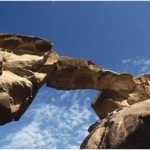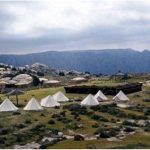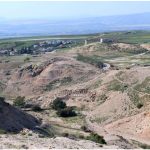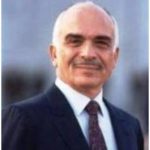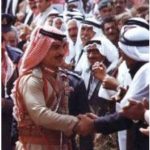| Official language | Arabic |
| Capital | Amman |
| Form of government | constitutional hereditary monarchy |
| Area | 88.582 km² |
| Residents | 5,480,000 |
| Currency | dinar |
| Time zone | UTC + 2 |
| License plate | JOR |
| Internet TLD | .jo |
| Telephone area code | 00962 (Source: ALLCITYCODES) |
Geography
The Hashimite Kingdom of Jordan (in Arabic Al-Urdunn, officially Al-Mamlaka al-Urdunnijja al-Haschimjja) is located in the Near East. With an area of 88,582 km², the kingdom is about the size of Austria. Jordan has four neighboring countries: Israel in the west,Syria in the north, Iraq in the northeast and Saudi Arabia in the east and south. A 26 km long coastline connects the country with the Gulf of Aqaba, which provides access to the Red and thus to the open sea. See Jordan country abbreviation.
Jordan is divided into three landscape areas: firstly, the Jordanian part of the Jordan ditch, secondly, the East Jordanian highlands (here the Jabal Ram stands at 1,754 m, the highest mountain in the country) and thirdly, the desert plains in the east. These are structured by so-called wadis, deeply carved valleys, and belong to the great Arabian desert. On the border with Israel, Jordan shares in the Dead Sea (Arabic: Al-Bahr-al-Maijit), an outflow-free salt lake that is almost twice as large as Lake Constance at 1,020 km². Its lowest point is 398 m below sea level, making it the deepest landscape on the earth’s surface. The longest and water-richest river in the country is the Jordan (Arabic Al-Urdunn). It is 330 km long and originates in the area between Syria, Lebanon and Israel. Through the Hule Valley,
Climate
Arid continental climate shapes most of the kingdom. The annual rainfall in these regions is between 200 and 250 mm per year. For comparison: In Germany, the average annual rainfall is more than three times as high. The situation is different on the mountainous slopes that descend steeply to the Jordan ditch, where incline rain leads to annual rainfall of up to 700 mm, which makes rainfield cultivation possible. Temperatures fluctuate between 8 °C in January and 25 °C in July (in the capital Amman, which is located on the East Jordanian plateau). Frost only occurs at higher altitudes.
Flora and fauna
The vegetation of Jordan is different depending on the climatic conditions. The mountain country shows a Mediterranean tree and shrub vegetation. This is known as garrigue (French-Provencal for Kermese oak) and consists of hardwood dwarf shrubs, but also other types of shrubs such as rosemary and lavender. In the steppes, on the other hand, there are large areas of grass that are interrupted by individual trees and shrubs. Dwarf and thorn bushes and wormwood plants grow here. There are hardly any plants in the deserts, only after the short winter rains the sparse vegetation blooms for a short time in the deeply cut river valleys (wadis), which are a bit wetter.Tamarisk trees with their scaly leaves and pink flower clusters, as well as umbrella acacias (from the plant genus of mimosa) grow in the wadi regions. Only a small part of Jordan has forests. These can be found in the mountainous highlands of the country and mainly consist of oak, olive and pine trees. Subtropical gallery forests grow on the banks of the Jordan.
Jordan’s wildlife is more diverse than you might think. Wild goats are striking, which can be found especially in the canyons near oases. But also wild boar and ibex, rabbits, jackals, foxes, hyenas, wild cats and wolves as well as gazelles, chamois and – rarely – panthers are wild animals in Jordan. Scorpions and lizard species can also be observed. The most striking of the numerous bird species are golden eagles and vultures.
Population
According to COUNTRYAAH, 99% of the Jordanian population are Arabs, the proportion of Muslims (Sunnis) is correspondingly high at 93%. The majority of the small group of non-Arabs are of Armenian origin. Islam is the state religion. Only a small minority of 5% consists of Christians, the majority of them Greek Orthodox.
Of the 5.48 million residents, 1.15 million live in the country’s capital, Amman. Other cities are Zarqua with 428 700 residents and Irbid with 247 300 residents. The official language is Arabic, although the written classical Arabic differs significantly from the colloquial language. The literacy rate is 91%. According to estimates, two thirds of Jordanians consider themselves to be Palestinians. The former refugees are largely integrated; unlike in the other Arab refugee countries, they have full civil rights, so they can participate in political life as equal citizens.
The population growth in Jordan is a high 2.3%, life expectancy on average 78 years.

Political system
Jordan is a hereditary constitutional monarchy under the 1952 constitution. The king (Abdullah II since February 1999) is also head of state, commander-in-chief of the army and holder of executive power. He appoints the Prime Minister (Abdullah Ensur since October 2012), the Senate members and the Kingdom judges. Legislative power rests with Parliament, which is divided into two chambers. One is the House of Representatives with 150 members elected for four years. 27 of them are elected by proportional representation at the state level, 108 at the local level by majority vote. Another 15 seats are reserved for women. The other chamber is the Senate, whose 60 members are appointed by the king for four years.
The legal system is based on Islamic and French law, the International Court of Justice is not recognized by the Kingdom as an instance.
The country’s administration is divided into twelve administrative districts.
Economy
The basic economic conditions for the kingdom are difficult. There are no own sources of energy, and the notorious water shortage and high population growth present the country with major problems. The existing economic structures are based on a limited internal market. 15% of Jordanians live in poverty, the official unemployment rate of 15% must probably be doubled in order to maintain real value. Efforts to liberalize and integrate the economy internationally (eg via a free trade agreement with the United States and association agreements with the EU) have not been very successful since 1999, especially since the dependence on oil supplies from other Arab countries increased drastically after the 2003 Iraq was.
The shortage of water in recent years has had a major impact on agricultural exports. Cereals, lentils, sweet peas, tobacco, tomatoes, olives, figs and pomegranates are grown in the Jordan ditch in particular – often supported by artificial irrigation. Citrus fruits, bananas and melons are also important crops.
68% of the gross domestic product is generated in the service sector, in the industrial sector 29%. The industrial sector is dominated by phosphate mining, and Jordan is the world’s second largest exporter of this raw material. Accordingly, the country’s main industrial operations are a phosphate factory, a cement plant and an oil refinery. In addition to Iraq, the most important export customers include the USA, India and Saudi Arabia. The most important import goods are petroleum, chemical products, food, vehicles, machines and industrial goods, preferably chemicals (medicines and fertilizers), phosphate products (phosphate and potash), textiles as well as fruits and vegetables are exported.
The ancient cities of Petra, Aqaba, Gerasa and the desert castles of the Umayyad caliphs form the basis for a flourishing tourism, which is an important source of foreign currency for the country, which is poor in raw materials.
Jordan is a member of the WTO. An economic free zone in the region of the port city of Aqaba has been open since 2001. The country’s international airports are located in Amman and Aqaba.
The Jordanian currency is the dinar (= 1,000 fils).
